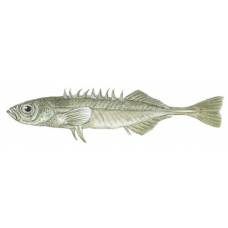Latin name
Pungitius pungitius
Other names
No information
Identification
The stickleback gets its name from the short and long spines on the first dorsal fin, the number of which is usually used to determine the species. Each member of the family has 3 to 26 well-developed isolated dorsal spines that precede the normal dorsal fin with 6-14 rays. Almost every species also has a spine on the anterior edge of the anal fin and on each pelvic fin. The body is scaleless, but in most species it is armored on the sides with bony plates. Several species of sticklebacks are kept in aquariums. They swim with short jerks and then pause. This makes them interesting to watch, as does their spawning ritual, which is unlikely to be seen in the wild. The Brook Stickleback (Culaea inconstans) has five or six spines on its back that are completely separate and not connected by a band, and its tail spine is particularly thin. The nine-spined stickleback (Pungitius pungitius) has a dark brown coloration, and the male becomes deep black during courtship and spawning.
Distribution
Sticklebacks are found only in the northern hemisphere, most commonly in North America. A common species in North America is the brook stickleback (Culaea inconstans), found in streams from southern Ohio west to Montana and north, and throughout southern Canada from Nova Scotia to eastern British Columbia. The three-spined stickleback (Gasterosteus aculeatus) is found in northern Eurasia and North America. Several subspecies are recognized. Nine-spine stickleback (Pungitius pungitius) is found in northern Europe, China, Japan, and northern North America. Fifteenspine stickleback (Spinachia spinachia) is a European saltwater species restricted to northwestern Europe. The fourspine stickleback (Apeltes quadracus) is found only on the east coast of North America, from North Carolina to the Gulf of St. Lawrence. The blackspotted or twospine stickleback (G. wheatlandi) is another western Atlantic species.
Habitat
They are predominantly freshwater fish, but some are found in brackish or shallow coastal waters of the oceans. The three-spined stickleback (Gasterosteus aculeatus) lives in both brackish and fresh water.
Size
Sticklebacks rarely exceed 3 inches in length. The brook stickleback (Culaea inconstans) usually does not exceed 31⁄2 inches.
Life history and Behavior
During spawning, the males assume a courtship coloration: some have bright red bellies, while others are velvety black. Each male builds a nest among the stems of aquatic plants. The nest is hollow on the inside, but completely covered at the top, bottom, and sides by stems held together by sticky threads. Once the nest is built, the male locates the female and drives her to the nest, pinching her flippers and chasing her if she turns the wrong way.
Food and feeding habits
No information
Reproduction
Once the female has laid her eggs, she leaves the nest, sometimes climbing out through the bottom. The male immediately enters the nest and fertilizes the eggs. Often he will come out again and get one or two more females to lay eggs in the nest. Some males build several nests at once. The eggs hatch in a week or less. While the eggs are incubating, males of most species aerate them by running streams of water through the nests (a male of one species builds a nest with two holes in the top and sucks water from one of the holes to circulate water over the eggs). After the eggs hatch, the male cares for the young for a few days, usually trying to keep them close to the nest.
Interesting facts
Quarrels often occur between males of the Ninespine stickleback species. When a brightly colored male ready to spawn appears in the territory of another male, the "host" immediately rushes at the intruder. The red belly of the guest is what mainly "acts on the nerves" of the future daddy. If the intruder is not frightened and does not leave, the fish threaten each other with gestures. They stand on their heads and show their sides with their spines pointing outwards. Occasionally, they grab a blade of grass from the bottom as if to say, "I'm busy building a nest; swim on by." Sometimes, however, a fight ensues, and the opponents begin to pounce on each other, trying to pinch or prick with their mouths or needles. The winner is almost always the owner of the territory because, as they say, "Houses and walls help."
| Classification | |
| Phylum | Chordata |
| Class | Actinopterygii |
| Squad | Scorpaeniformes |
| Family | Gasterosteidae |
| Genus | Pungitius |
| Species | P. pungitius |
| Features | |
| Conservation status | Least Concern |
| Habitat | Pelagic |
| Life span, years | No information |
| Maximum body weight, kg | No information |
| Maximum length, cm | 7.62 |
| Sailing speed, m/s | No information |
| Threat to people | No information |
| Way of eating | No information |
Ninespine Stickleback
Tags: ninespine stickleback





